home
A detailed look at who wrote Marvel stories between 1958-1963
Patrick Ford
22 October 2016 
Who wrote the mlonster stories?
The comment by Michael J. Vassallo was brought to my attention.
Michael J. Vassallo: I purposefully spoke in general terms with regards to these stories. Unless Lieber scripts turn up, it's always going to be unresolved, in my opinion. More and more I'm thinking there was a massive amount of unused scripts after Atlas imploded. I already know there were nearly 30 from Carl Wessler alone. Add up to perhaps 4 or 5 different writers and that leaves around 150 orphaned scripts. Ok..that covers generic science fiction of the first year. Kirby did some sci-fi stories that first year and I'm betting he wrote them himself. I don't think he "needed" plots. But it's certainly likely and probable that Stan or Larry dialogued them. They don't read as Jack's dialogue. After the first year sci-fi morphed to monster for Kirby while Ditko continued along with twist-ending type stories. There are still no writing credits anywhere. Who is writing the Reinman, Heck, stories? Those are possibly where many of the orphaned scripts went. And they were probably re-written by Lee or Lieber. My guess is Lieber, not Lee. Lee was writing westerns and teen at this time AND SIGNING THEM! Ditko's stories start bearing a Lee signature in October 1961 but I'm positive he was scripting them almost from the beginning of the year. Why he didn't sign them at the start, I don't know. This is the only time I've ever seen where he purposely left his name off. The Kirby monsters are a different animal, and the subject of this Omnibus. I have no idea, from individual story to story, who did what. I'm thoroughly convinced Jack Kirby quite possibly and likely plotted many of them. But many are quite dumb and the premise for many are all the same. If you read Kirby's sci-fi fantasy from the 1950's that he wrote, many of those stories are very well written, not like these monster -of-the-month stories. So I just said he likely plotted many of them but he also likely did not plot the rest. Lieber is on record stating he always provided a full script for the monster stories. That's what I meant by "late" monster stories... 1961-62.. Fin Fang Foom, etc..Lieber said he discussed plots with Stan beforehand. All of them? I don't know. The answer is probably a mixture. Some Jack plotted, some Stan plotted and Larry typed into a script. Just because Larry said he wrote full scripts doesn't mean he wrote "every" full script. If I'm sounding vague, it's because it IS vague. I don't think anyone is 100% correct here, including me. I don't have a perfect answer. All I know is that the Omnibus was originally created with the title "The Monster Stories of Jack Kirby" or something similar, as the title. Marvel's lawyers insisted the change be made or the book would be squashed.
Patrick Ford: Here are my thoughts on Michael Vassallo's comments.
1. The thought that there were a very large number of inventory scripts being used from late 1958 through 1961 (and maybe ever later) is a good one. It makes logistical sense. Due to the "implosion" Martin Goodman would have had a large (likely very large) number of scripts which had already been purchased prior to Goodman's distribution problems.
Patrick Ford:
2. Like Michael Vassallo I don't think the inventory scripts account for Kirby's stories. Kirby's stories from the start ("I Discovered the Secret of the Flying Saucers") are different from the other stories being published in 1958 and 1959 when most of the inventory scripts were probably used.
Patrick Ford:
3. It's not possible for me to say if Kirby's dialogued the early (and late) science fiction-fantasy-monster stories. I have not seen enough of them to be sure. The ones I have seen do not jump out at me as being easily identified as dialogued by Kirby. They don't remind me all that much of Lee either. As to the possibility they were dialogued by Larry Lieber I have no idea. Mark Evanier has written that Stan Lee and Sol Brodsky both told him Lee heavily rewrote Larry Lieber's dialogue and captions.
Patrick Ford:
4. My guess is Kirby wrote his own stories and submitted them to Lee with captions and dialogue. How much of Kirby's captions and dialogue made it to the printed page would require close study to determine. My sense if Lee rewrote enough of the dialogue to sufficiently muddle things. I just know that in the monster stories I have read there are not any memorable bits of dialogue or captions which jump out as obviously Kirby.
Patrick Ford:
5. I'm skeptical that Lee began writing stories for Ditko prior to the time Lee began signing them. Those unsigned stories may be Lee taking a more aggressive role in rewriting whatever dialogue was supplied in the original script. Ditko has written he never once got a script from Stan Lee. It might be interesting to see if by 1961 Martin Goodman had shifted the balance of his line more heavily towards monster/fantasy titles and perhaps that allows Lee the time to become more involved in editing those titles.
Patrick Ford:
6. The original art for the early science fiction and fantasy pages published by Goodman tend to be far more free from signs of editing than are anything published after 1962. When I look at pages from 1958-fall of 1961 I don't see many art "corrections," text corrections, or Lee's notes asking for changes written on the margins.
Patrick Ford:
7. The monster stories are "dumb." Or at best very limited. Kirby complained about this himself. Does that mean Kirby didn't write them (at least in the pencil stage)? I don't think so. It could be Kirby was under orders from Goodman to keep cranking out the "monster of the month" type story. Kirby was also confined by the CBCA. And if Kirby's dialogue and captions were being rewritten that alone would tremendously alter the whole tone of the stories. In fact just changing the dialogue and captions at key points would totally gut that sort of story.
Patrick Ford: 8. I have to wonder if it was Marvel's lawyers or Stan Lee's lawyers who insisted on the change in credits? Or perhaps Marvel's lawyers after they got an earful from Lee's lawyers. It's my understanding (I've been told) that the Kirby's are aware of this and it remains to be seen how the credits on the book will read. It will probably come down to the language in Stan Lee's contract v. the language in the settlement agreement Marvel negotiated with the Kirby's.
I suppose I would be satisfied if Kirby was crediting with writing and drawing. I could see Lieber and Lee getting writing credit as well since I assume that both Lieber and Lee did rewrite the text in the published stories. I just don't want to see Kirby not get a writing credit and hope that any introduction does not repeat the usual claims that Lieber wrote full scripts based on Lee's plots.
Ferran Delgado: After checking out many comics by Kirby searching for his writing inside of the balloons, and discovering that I just could find them in the comics theoretically written by Lieber or Berns; Style of the writing doesn't look like Kirby according to Vassallo; Lieber claimed that he wrote full scripts; stories are dumb; etc... I'm quite pessimistic about Kirby delivering stories completely written. I wish it was quite the opposite, but I couldn't find a comic produced only by Kirby and Lee with Kirby's writing inside of the balloons. Unfortunately, I think that Lee worked from a full script by the Liebers.
Ferran Delgado: I think that it's not a coincidence that Brevoort replied to other questions but not the one related to the monsterbus. And we already know his position towards Kirby.
Patrick Ford: As Vassallo says the lack of any scripts by Lieber leave this an open question. Clearly Kirby's handwriting is evident in the balloons and captions on stories not signed by Lee. However Kirby's lettering in pencil is so obscured by the inked lettering that it is impossible to read more than snatches of it. And there are no Lieber scripts to compare anything to.
It's true that as far as we have seen on stories signed by Lee there are none which have turned up which have Kirby's penciled lettering in the balloons and captions. However, Lee was not working on the fantasy-monster books prior to late 1961 and that means Lee was generally not involved with stories by Kirby.
Patrick Ford: It does not surprise me Brevoort did not reply. It's apparently a legal issue and one which may not yet be resolved.
Patrick Ford: Another thing to consider with the Silver Age Marvel work is the fact that we have only seen a small fraction of it. And an even smaller fraction of the early work. And there are things we don't know about that work. When you consider the "Man called D.E.A.T.H." presentation [the original "Agent of SHIELD"]and the fact the text was never talked about until recently, or the fact that Kirby's Spider-Man pages are still being hidden, I think it is perfectly reasonable to question whether Marvel would have hidden, destroyed, or altered anything which would have been seen as a threat to the claim Lee was creating the character and plot ideas. That would include the possibility of erasing anything written on the back of a page, or simply making sure those pages were never seen. Marvel had decades to consider what they wanted to be seen and what they wanted to hide.
The physical evidence
Patrick Ford: Consider this. What is the actual physical evidence. The physical evidence ends with Kirby's writing in the balloons and captions. There are no Lieber scripts. Imagine for a moment if there were Lieber scripts and no Kirby lettering. Would there even be a discussion? So why is there a discussion? Decades of programming.
Ferran Delgado: I understand, but some key stuff was robbed from Marvel warehouse which eventually might surface, as it happened. I know about the famous box stolen from Marvel offices, but prior to that, lots of stuff disappeared which might jeopardize the official story spread by Marvel.
Ferran Delgado: In fact, mostly of the stuff seen at WhatifKirby was not returned to Kirby.
Patrick Ford: Ferran Delgado see my comment asking about FF #5 and AF #15. Do you have scans showing Lee's penciled lettering on pages from AF #15 ?
Ferran Delgado: The scans of AF #15 published in the SpM Masterworks TPB #1 doesn't show anything since printing was awful.
Ferran Delgado: They look clean or cleaned. Usually the inker has to erase any trace of pencils so they don't get reproduced. I'm not surprised that pages are erased, I'm surprised that some pages weren't.
Patrick Ford: However look at the Dr. Droom pages where Ditko inked Kirby. Ditko didn't erase very much at all. Those are some of the best pages to look at for evidence of Kirby's lettering. You can even easily see where Ditko ignored Kirby's backgrounds.
Ferran Delgado: Ditko and any other inkers are supposed to erase pencils, I don't understand why they didn't.
Patrick Ford: Some did, some didn't. Seems Ditko wasn't very interested in erasing.
Ferran Delgado: https://blogs.loc.gov/loc/2008/04/library-of-congress-acquires-spider-mans-birth-certificate/
Ferran Delgado Blake Bell used to have ALL the original art showed at his site, but it's long down. It was http://www.ditko.comics.org/
Ferran Delgado: Go figure! This looks like some writing. By Lee? The photo was taken by Bell. 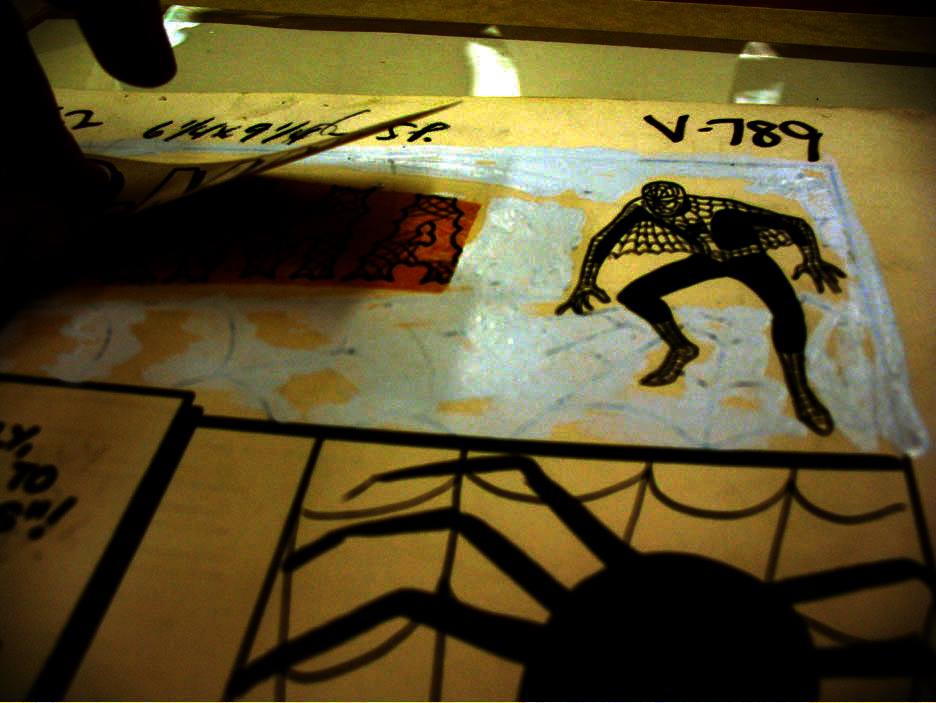 Ferran Delgado: http://ferrandelgado.blogspot.com/2008/05/ms-revelaciones-en-los-originales-de.html
Patrick Ford: There is something there. This should be easy to nail down. Someone must have posted high quality scans from AF #15 on the web.
Ferran Delgado: https://comicsforum.org/2012/08/13/the-art-of-the-cartoon-exploring-the-collections-of-the-library-of-congress-by-sara-w-duke/
Patrick Ford: Here's a large scan of a panel I found. Lot's of pencil including notes, guidelines, and pencil in the art which Ditko changed when he inked. No penciled in dialogue or captions.
Ferran Delgado: http://ferrandelgado.blogspot.com/2008/05/ms-revelaciones-en-los-originales-de.html
Patrick Ford: There is something there. This should be easy to nail down. Someone must have posted high quality scans from AF #15 on the web.
Ferran Delgado: https://comicsforum.org/2012/08/13/the-art-of-the-cartoon-exploring-the-collections-of-the-library-of-congress-by-sara-w-duke/
Patrick Ford: Here's a large scan of a panel I found. Lot's of pencil including notes, guidelines, and pencil in the art which Ditko changed when he inked. No penciled in dialogue or captions.
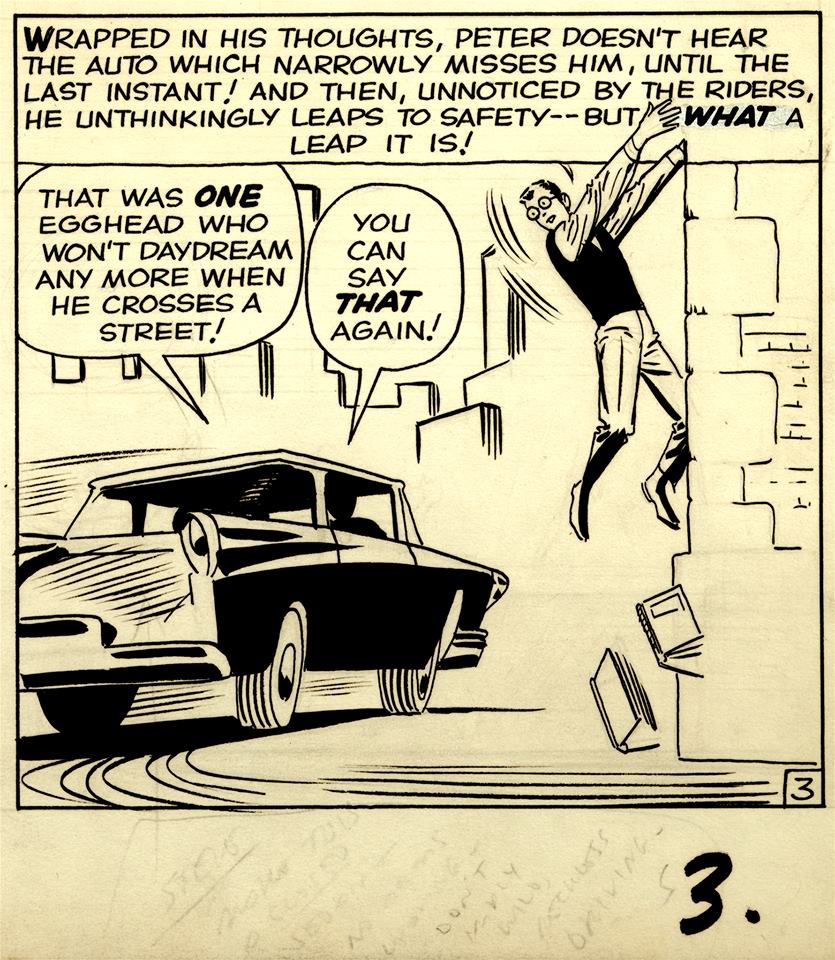 Patrick Ford: Interesting that the caption, the dialogue, the note, and the artwork are all out of sync.
Patrick Ford: Particularly the way the caption contradicts the dialogue.
erran Delgado: For example, in the third page Stan Lee writes Steve Ditko a short note in the lower margin of the page that affects art that had already been inked, -Steve, make this a sedan -� no arms hanging -� don't imply wild reckless driving.-�
Patrick Ford: Interesting that the caption, the dialogue, the note, and the artwork are all out of sync.
Patrick Ford: Particularly the way the caption contradicts the dialogue.
erran Delgado: For example, in the third page Stan Lee writes Steve Ditko a short note in the lower margin of the page that affects art that had already been inked, -Steve, make this a sedan -� no arms hanging -� don't imply wild reckless driving.-�
 Ferran Delgado: If rulers are visible, no erasing was done in balloons and captions.
Ferran Delgado: Each page of the SpM Masterworks has comments by Bell where includes the notes at the margins.
Patrick Ford: AF #15 was published the same month as FF # 5 which has Lee's penciled dialogue in the balloons and if I recall what looks like traces of Kirby's penciled lettering in the balloons.
Ferran Delgado:
Ferran Delgado: If rulers are visible, no erasing was done in balloons and captions.
Ferran Delgado: Each page of the SpM Masterworks has comments by Bell where includes the notes at the margins.
Patrick Ford: AF #15 was published the same month as FF # 5 which has Lee's penciled dialogue in the balloons and if I recall what looks like traces of Kirby's penciled lettering in the balloons.
Ferran Delgado:
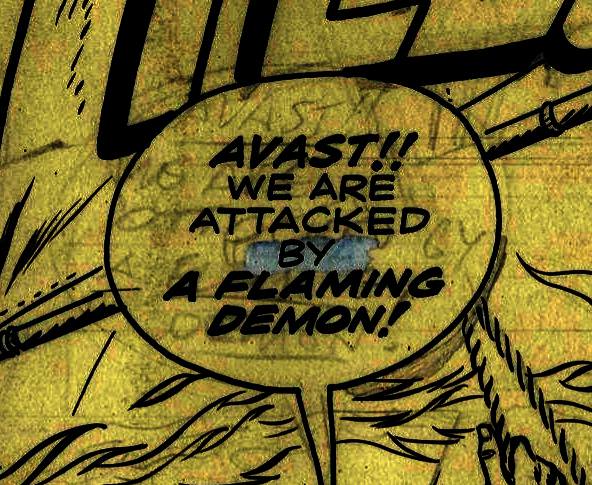
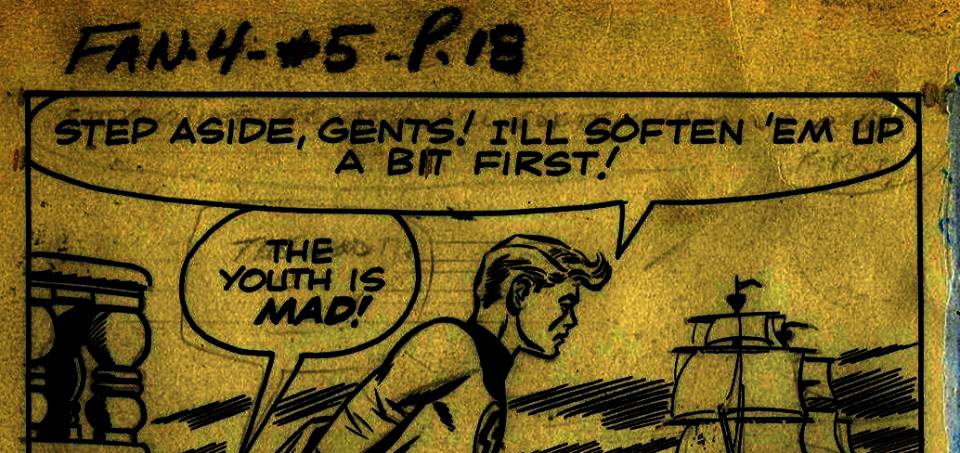 Patrick Ford: I think I can find an example where it's pretty clear there is penciled lettering by Kirby and Lee in the same balloon. I've seen it before and just need to find a good example.
Ferran Delgado: If you can see the rulers, Lee didn't erase it.
Ferran Delgado:
Patrick Ford: I think I can find an example where it's pretty clear there is penciled lettering by Kirby and Lee in the same balloon. I've seen it before and just need to find a good example.
Ferran Delgado: If you can see the rulers, Lee didn't erase it.
Ferran Delgado:
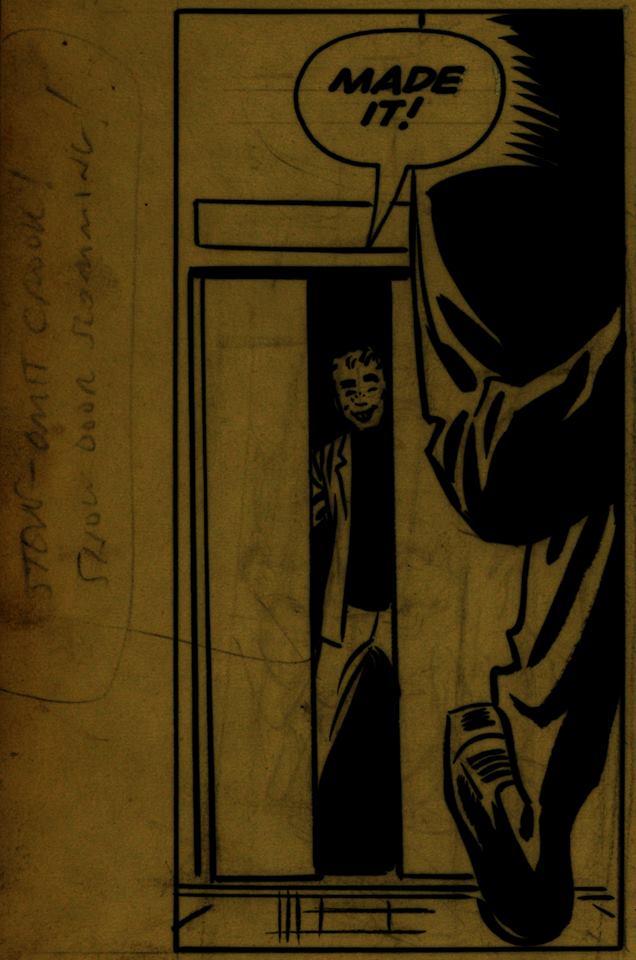 Ferran Delgado: Lettering by Lee in the balloons, as told by Bell in his notes.
Ferran Delgado: Lettering by Lee in the balloons, as told by Bell in his notes.
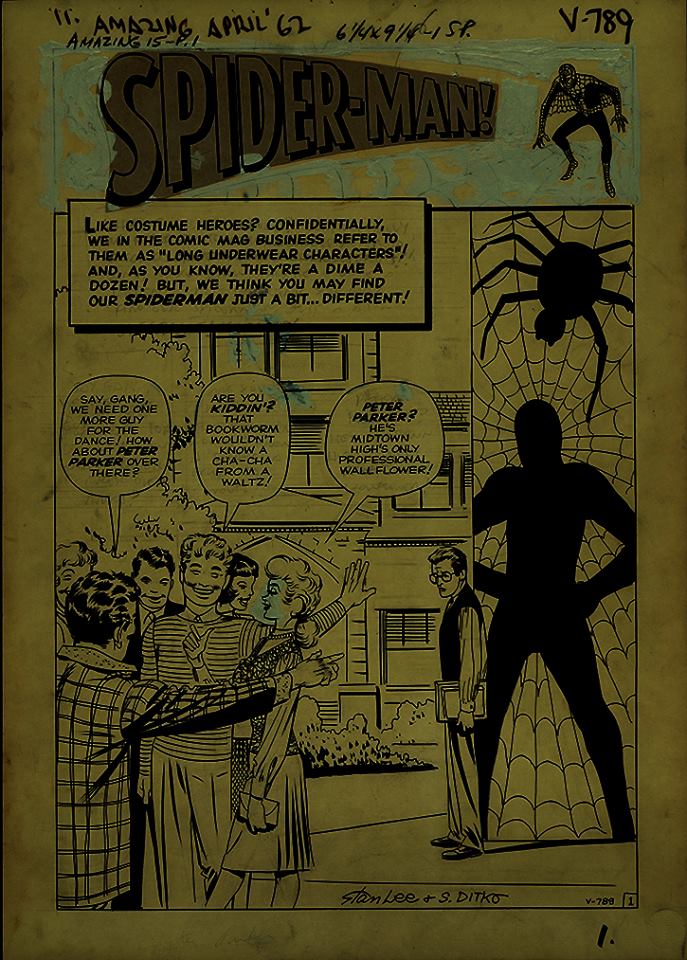 Patrick Ford: I can see some in there but not on some other pages.
Patrick Ford: Here's a good example of Lee lettering in pencil on the art pages. This is ASM #7 from 1963.
Patrick Ford: I can see some in there but not on some other pages.
Patrick Ford: Here's a good example of Lee lettering in pencil on the art pages. This is ASM #7 from 1963.
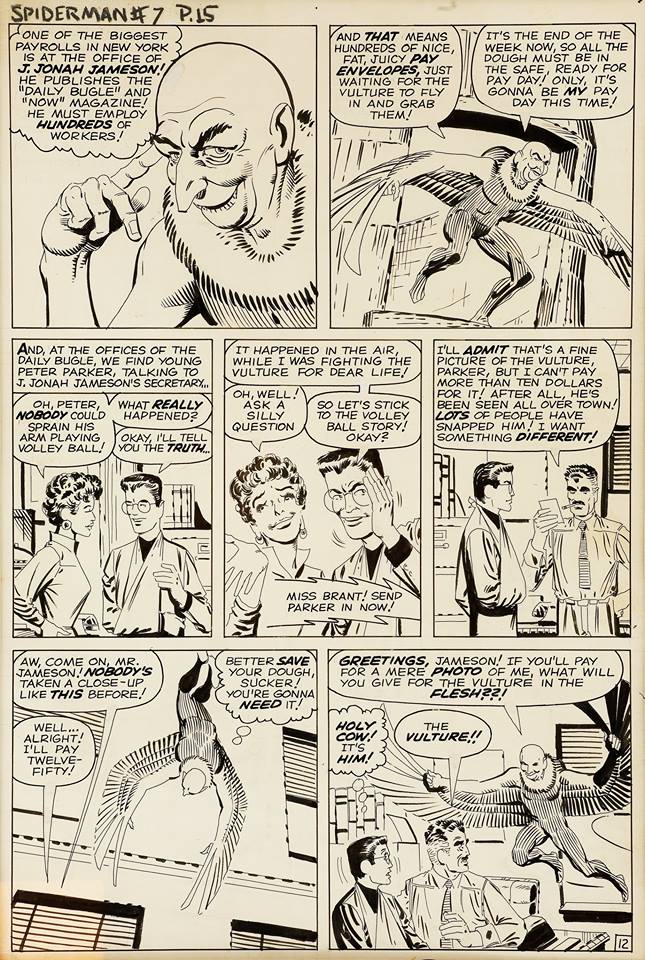
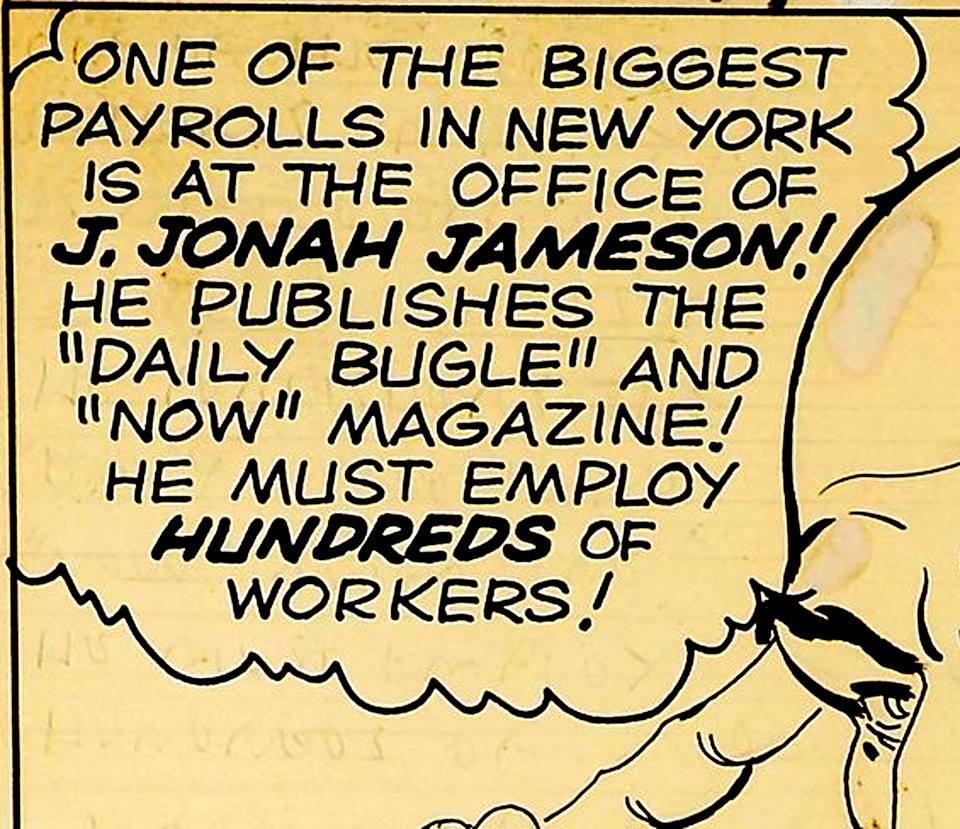 Ferran Delgado:
Ferran Delgado:
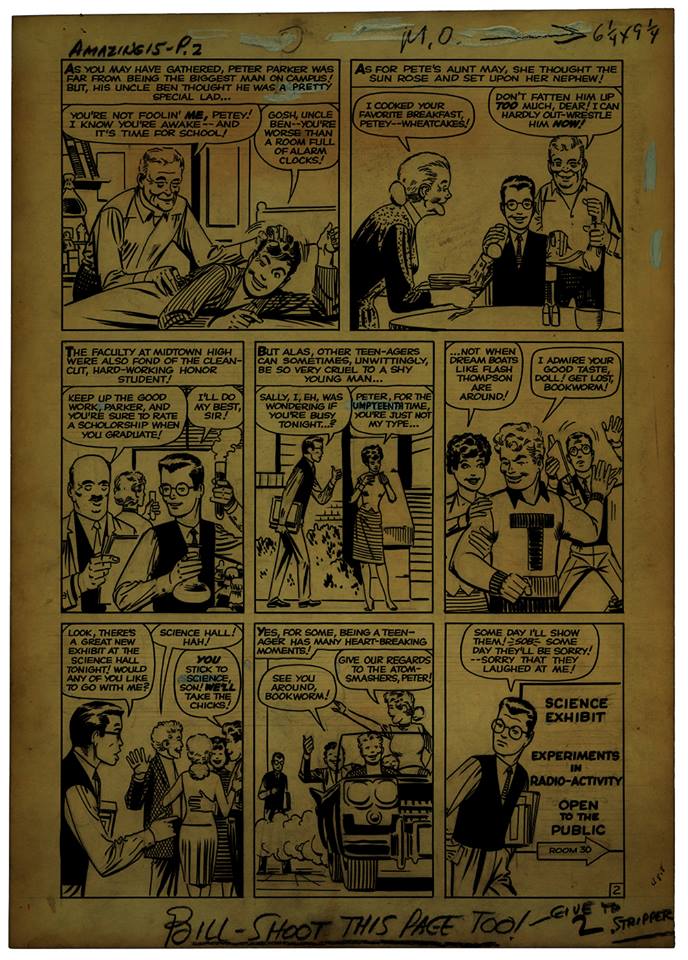 Patrick Ford: "Bill" .... Everett? The "give to stripper" note is funny even though it does not refer to a Janet Clover type stripper.
Ferran Delgado: https://ohdannyboy.blogspot.com/2013/04/who-created-amazing-spider-man-amazing.html
Michael Hill: Where does Best come up with such nonsense? He uses this diatribe to say Kirby accused Ditko of theft, and Ditko rebutted *Kirby's* claim. I'd say Kirby and Ditko are in agreement against Lee.
Patrick Ford: Further study is needed but it seems Lee began penciling in dialogue and captions on the art boards right around the time he began taking published credits credits in the comic books. Prior to that he must have been typing a "dialogue script" And after a short time he returned to typing the dialogue rather than penciling it on the art.
Patrick Ford: At Tom Kraft's "What If Kirby" page FF #3 has Lee's penciled lettering on the original art. By issue #9 it looks to be gone and Lee is just doing balloon placements and sound effects in pencil.
Patrick Ford: FF #13 is a good issue to examine. Ditko does not waste time doing heavy erasing. It's easy to see the way he's not following Kirby's pencils very closely. See the shading Ditko ignores on the Thing's torso in panel eight. It should be easy to see any penciled lettering in the balloons on the page and there is none.
Patrick Ford: "Bill" .... Everett? The "give to stripper" note is funny even though it does not refer to a Janet Clover type stripper.
Ferran Delgado: https://ohdannyboy.blogspot.com/2013/04/who-created-amazing-spider-man-amazing.html
Michael Hill: Where does Best come up with such nonsense? He uses this diatribe to say Kirby accused Ditko of theft, and Ditko rebutted *Kirby's* claim. I'd say Kirby and Ditko are in agreement against Lee.
Patrick Ford: Further study is needed but it seems Lee began penciling in dialogue and captions on the art boards right around the time he began taking published credits credits in the comic books. Prior to that he must have been typing a "dialogue script" And after a short time he returned to typing the dialogue rather than penciling it on the art.
Patrick Ford: At Tom Kraft's "What If Kirby" page FF #3 has Lee's penciled lettering on the original art. By issue #9 it looks to be gone and Lee is just doing balloon placements and sound effects in pencil.
Patrick Ford: FF #13 is a good issue to examine. Ditko does not waste time doing heavy erasing. It's easy to see the way he's not following Kirby's pencils very closely. See the shading Ditko ignores on the Thing's torso in panel eight. It should be easy to see any penciled lettering in the balloons on the page and there is none.
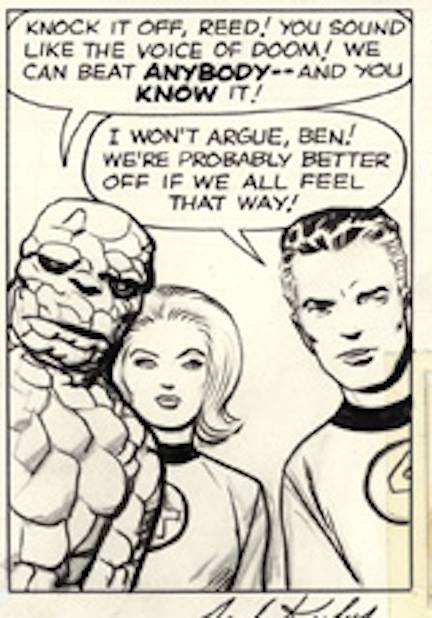 https://whatifKirby.com/gallery/comic-art-listings/fantastic-four-issue-13-page-22
Patrick Ford: RAWHIDE KID #31, Dec. 1962 does not appear to have any penciled dialogue in the balloons.
https://whatifKirby.com/gallery/comic-art-listings/rawhide-kid-issue-31-page-5
Patrick Ford: RAWHIDE KID #28, June 1962 does show the penciled dialogue.
https://whatifKirby.com/gallery/comic-art-listings/rawhide-kid-issue-28-page-5
Ferran Delgado: By Lee.
Patrick Ford: Yes. It's Lee's penciled lettering.
Patrick Ford: Ferran Delgado, See what you can do with this page. I don't have the same tools you have and can't copy a zoomed image from What If. It looks to me like RAWHIDE KID #20 might have Kirby's lettering in the balloons.
https://whatifKirby.com/gallery/comic-art-listings/rawhide-kid-issue-20-3rd-story-page-1
Patrick Ford: Also of interest is the caption on the splash page (Chapter 2) for the new teenage Rawhide Kid. Hard to make out but the penciled lettering look to have the distinctive Kirby / to the right. It also looks typically precise. It's faint though and hard to see.
Ferran Delgado: I make screenshots of the zoomed image.
https://whatifKirby.com/gallery/comic-art-listings/fantastic-four-issue-13-page-22
Patrick Ford: RAWHIDE KID #31, Dec. 1962 does not appear to have any penciled dialogue in the balloons.
https://whatifKirby.com/gallery/comic-art-listings/rawhide-kid-issue-31-page-5
Patrick Ford: RAWHIDE KID #28, June 1962 does show the penciled dialogue.
https://whatifKirby.com/gallery/comic-art-listings/rawhide-kid-issue-28-page-5
Ferran Delgado: By Lee.
Patrick Ford: Yes. It's Lee's penciled lettering.
Patrick Ford: Ferran Delgado, See what you can do with this page. I don't have the same tools you have and can't copy a zoomed image from What If. It looks to me like RAWHIDE KID #20 might have Kirby's lettering in the balloons.
https://whatifKirby.com/gallery/comic-art-listings/rawhide-kid-issue-20-3rd-story-page-1
Patrick Ford: Also of interest is the caption on the splash page (Chapter 2) for the new teenage Rawhide Kid. Hard to make out but the penciled lettering look to have the distinctive Kirby / to the right. It also looks typically precise. It's faint though and hard to see.
Ferran Delgado: I make screenshots of the zoomed image.  Patrick Ford: I'm not convinced but I think the penciled SLU (slung) next to the inked ARE looks a lot like Kirby.
Ferran Delgado: I agree, but it's not definitive.
Patrick Ford: Hard to be certain but I think it looks more Kirby than Lee. Lee's printing is always poorly spaced and he wanders up and down from where you would expect the letters to share a baseline.______
Ferran Delgado: Hard to see who wrote it, not a clear word.
Ferran Delgado:
Patrick Ford: I'm not convinced but I think the penciled SLU (slung) next to the inked ARE looks a lot like Kirby.
Ferran Delgado: I agree, but it's not definitive.
Patrick Ford: Hard to be certain but I think it looks more Kirby than Lee. Lee's printing is always poorly spaced and he wanders up and down from where you would expect the letters to share a baseline.______
Ferran Delgado: Hard to see who wrote it, not a clear word.
Ferran Delgado:

 Patrick Ford: I wonder if the original art would be easier to read. Kirby's forms are distinctive. Particularly his R. Kirby also letters with a consistent forward lean //// and his letters are remarkably well spaced and grounded for someone not using guide lines. _____
Ferran Delgado: Another page from the comic at lesser resolution. Still hard to see. ()
Ferran Delgado: In this one it looks Lee's writing to me.
Patrick Ford: What about "Chapter 2" on the #18 splash?
https://whatifKirby.com/gallery/comic-art-listings/rawhide-kid-issue-18-page-8
Ferran Delgado: This is it!! From the #18 splash.
Patrick Ford: I wonder if the original art would be easier to read. Kirby's forms are distinctive. Particularly his R. Kirby also letters with a consistent forward lean //// and his letters are remarkably well spaced and grounded for someone not using guide lines. _____
Ferran Delgado: Another page from the comic at lesser resolution. Still hard to see. ()
Ferran Delgado: In this one it looks Lee's writing to me.
Patrick Ford: What about "Chapter 2" on the #18 splash?
https://whatifKirby.com/gallery/comic-art-listings/rawhide-kid-issue-18-page-8
Ferran Delgado: This is it!! From the #18 splash. 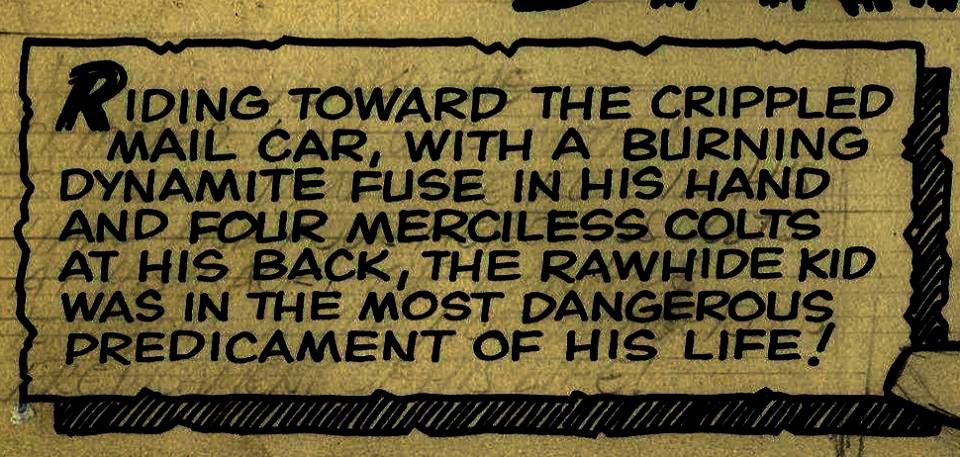 Patrick Ford: That's got to be Kirby.
Ferran Delgado: I agree!
Ferran Delgado: In a comic by Lee and Kirby.
Patrick Ford: And from the origin story no less.
Patrick Ford: Very interesting. Now will come the claims this confirms Lee was still writing full scripts at that time. (Oct. 1960).
Ferran Delgado: It's a possibility.
Patrick Ford: It is a possibility.
I wonder if Rand Hoppe or Tom Kraft can come up with a higher quality scan of that RAWHIDE KID #18 caption.
Patrick Ford: Tom's "What If Kirby" page has four pages from TWO-GUN KID #58, Feb. 1961. There are two pages from one story and two pages from another. All the pages look to have Kirby's penciled lettering in the balloons and captions. One of the pages has penciled lettering by Kirby and Lee in the same panel.
See the panel reading "Strangers gotta mind their manners."
https://whatifKirby.com/gallery/comic-art-listings/two-gun-kid-issue-58-page-1
Patrick Ford: One of the stories is a Western monster story "The Monster of Hidden Valley!" signed by Stan Lee and it clearly has Kirby's penciled lettering in the balloons and captions.
https://whatifKirby.com/gallery/comic-art-listings/two-gun-kid-issue-58-page-5
Patrick Ford: Splash page from "Chapter 2" of "The Monster of Hidden Valley." "Chapter 2" is lettered in pencil by Kirby and Kirby's lettering is in the balloons. http://https://whatifKirby.com/gallery/comic-art-listings/two-gun-kid-issue-58-page-8
Rand Hoppe:
Patrick Ford: That's got to be Kirby.
Ferran Delgado: I agree!
Ferran Delgado: In a comic by Lee and Kirby.
Patrick Ford: And from the origin story no less.
Patrick Ford: Very interesting. Now will come the claims this confirms Lee was still writing full scripts at that time. (Oct. 1960).
Ferran Delgado: It's a possibility.
Patrick Ford: It is a possibility.
I wonder if Rand Hoppe or Tom Kraft can come up with a higher quality scan of that RAWHIDE KID #18 caption.
Patrick Ford: Tom's "What If Kirby" page has four pages from TWO-GUN KID #58, Feb. 1961. There are two pages from one story and two pages from another. All the pages look to have Kirby's penciled lettering in the balloons and captions. One of the pages has penciled lettering by Kirby and Lee in the same panel.
See the panel reading "Strangers gotta mind their manners."
https://whatifKirby.com/gallery/comic-art-listings/two-gun-kid-issue-58-page-1
Patrick Ford: One of the stories is a Western monster story "The Monster of Hidden Valley!" signed by Stan Lee and it clearly has Kirby's penciled lettering in the balloons and captions.
https://whatifKirby.com/gallery/comic-art-listings/two-gun-kid-issue-58-page-5
Patrick Ford: Splash page from "Chapter 2" of "The Monster of Hidden Valley." "Chapter 2" is lettered in pencil by Kirby and Kirby's lettering is in the balloons. http://https://whatifKirby.com/gallery/comic-art-listings/two-gun-kid-issue-58-page-8
Rand Hoppe: 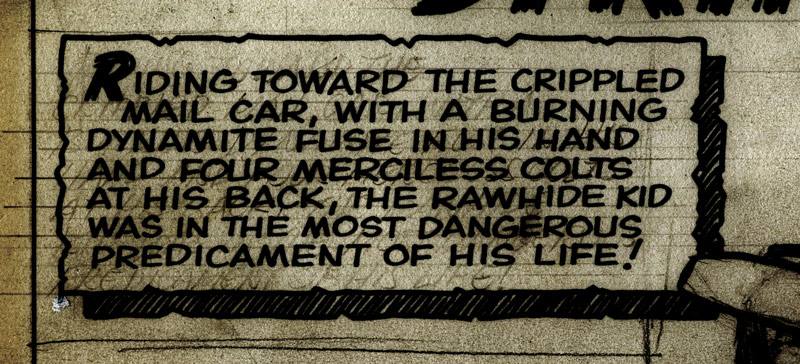 Patrick Ford: Thanks.
Ferran Delgado: The last line written by Kirby matches with the lettering.
Patrick Ford: It would be great if Rand Hoppe and Tom Kraft could examine closely all pages from the 1958-1962 era which they have scanned but have not yet posted. If "What If Kirby" was still an ongoing concern the 1958-1962 era would make a good sub-section.
Ferran Delgado: With the change of the name, Amazing Adult Fantasy #7 (12/1961) features only Ditko stories and they are credited in the splash and in the credits pages.
Patrick Ford: Thanks.
Ferran Delgado: The last line written by Kirby matches with the lettering.
Patrick Ford: It would be great if Rand Hoppe and Tom Kraft could examine closely all pages from the 1958-1962 era which they have scanned but have not yet posted. If "What If Kirby" was still an ongoing concern the 1958-1962 era would make a good sub-section.
Ferran Delgado: With the change of the name, Amazing Adult Fantasy #7 (12/1961) features only Ditko stories and they are credited in the splash and in the credits pages.  Ferran Delgado: Even in the cover!
Ferran Delgado: Even in the cover!  Ferran Delgado: Amazing Adventures #6 included a Kirby story unsigned (unusual), a story signed by Lee+Ditko, and a Paul Reinman just signed by him.
Ferran Delgado: Amazing Adventures #5 featured an unsigned Kirby story, another Don Heck unsigned story, and a Ditko story signed only by Ditko.
Patrick Ford: I'm pretty sure it was Ayers who signed all the Kirby/Ayers stories. The stories inked by Klein, Everett, Reinman and others are never signed.
Ferran Delgado: Amazing Adventures #6 included a Kirby story unsigned (unusual), a story signed by Lee+Ditko, and a Paul Reinman just signed by him.
Ferran Delgado: Amazing Adventures #5 featured an unsigned Kirby story, another Don Heck unsigned story, and a Ditko story signed only by Ditko.
Patrick Ford: I'm pretty sure it was Ayers who signed all the Kirby/Ayers stories. The stories inked by Klein, Everett, Reinman and others are never signed.  Mark Stichman: I think this one here is inked by Reinman.
Patrick Ford: Mark Stichman , It is. That's why it isn't signed. Reinman did sign work which he penciled but didn't sign stories penciled by Kirby which he inked.
Ferran Delgado: But GCD credits Ayers in 'Amazing Adventures' #5 which is unsigned. http://www.comics.org/issue/16503/
Patrick Ford: Around 1961 Lee began covering the Ayers "Kirby / Ayers" signature with white paint and then signing the stories Stan Lee and J. Kirby.
Mark Stichman: I think this one here is inked by Reinman.
Patrick Ford: Mark Stichman , It is. That's why it isn't signed. Reinman did sign work which he penciled but didn't sign stories penciled by Kirby which he inked.
Ferran Delgado: But GCD credits Ayers in 'Amazing Adventures' #5 which is unsigned. http://www.comics.org/issue/16503/
Patrick Ford: Around 1961 Lee began covering the Ayers "Kirby / Ayers" signature with white paint and then signing the stories Stan Lee and J. Kirby. 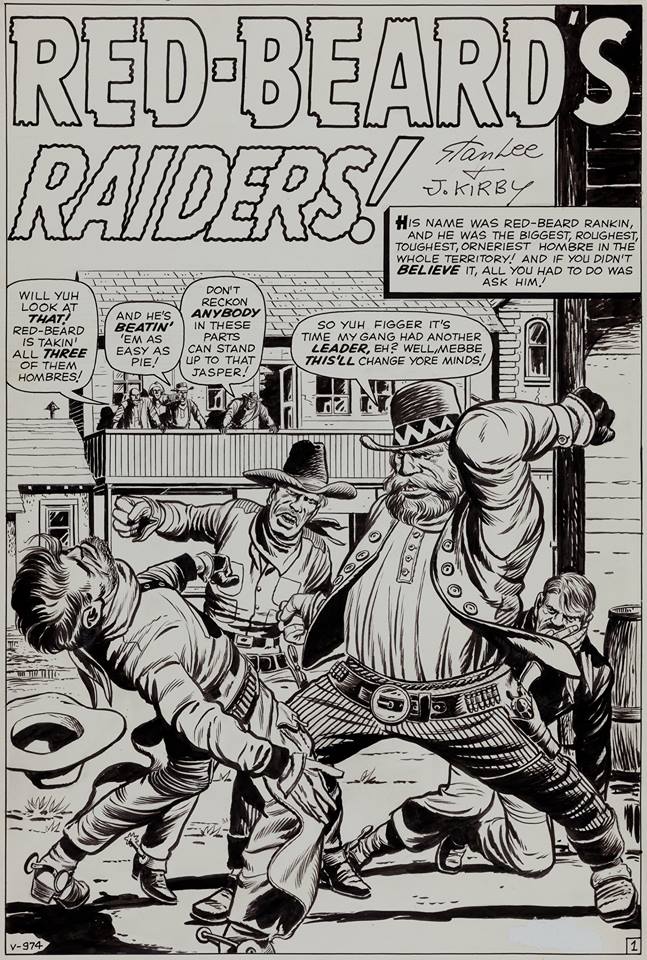 Ferran Delgado: This Kirby signature sure doesn't looks like done by him.
Patrick Ford: Roy Thomas said it was Stan Lee who wrote the signatures like that.
Ferran Delgado: This Kirby signature sure doesn't looks like done by him.
Patrick Ford: Roy Thomas said it was Stan Lee who wrote the signatures like that.  Patrick Ford:
Patrick Ford: 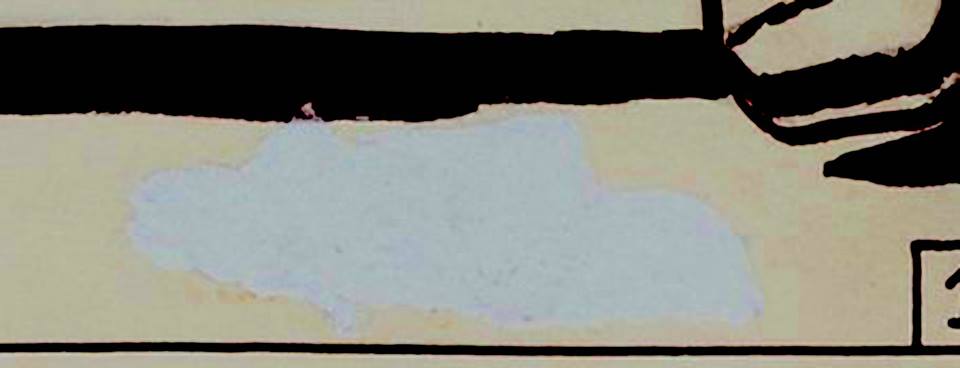 Ferran Delgado: It's curious that 'Amazing Adult Fantasy' #7 with the cover signed by Lee got released the next month than FF #1. When Lee signed the cover, FF #1 still didn't hit the stores, but probably he knew that it was something important.
Ferran Delgado: More curious. The same month that FF #1 got released, NO story by Kirby is signed, while the Ditko stories are signed by Lee+Ditko.
Ferran Delgado: Oh, and Lee didn't sign any story by Reinman.
Ferran Delgado: The stories inside of Kid Colt Outlaw #101 are signed by Lee and Keller/Ayers. Gunsmoke Western #67 has two stories signed by Lee+Ayers and another one by Lee+Keller. Kirby's are only signed by Lee.
Ferran Delgado: It's curious that 'Amazing Adult Fantasy' #7 with the cover signed by Lee got released the next month than FF #1. When Lee signed the cover, FF #1 still didn't hit the stores, but probably he knew that it was something important.
Ferran Delgado: More curious. The same month that FF #1 got released, NO story by Kirby is signed, while the Ditko stories are signed by Lee+Ditko.
Ferran Delgado: Oh, and Lee didn't sign any story by Reinman.
Ferran Delgado: The stories inside of Kid Colt Outlaw #101 are signed by Lee and Keller/Ayers. Gunsmoke Western #67 has two stories signed by Lee+Ayers and another one by Lee+Keller. Kirby's are only signed by Lee.  Patrick Ford: Reinman did a few Westerns in 1960 which he signed and which were also signed by Lee.
Patrick Ford: Reinman did a few Westerns in 1960 which he signed and which were also signed by Lee. 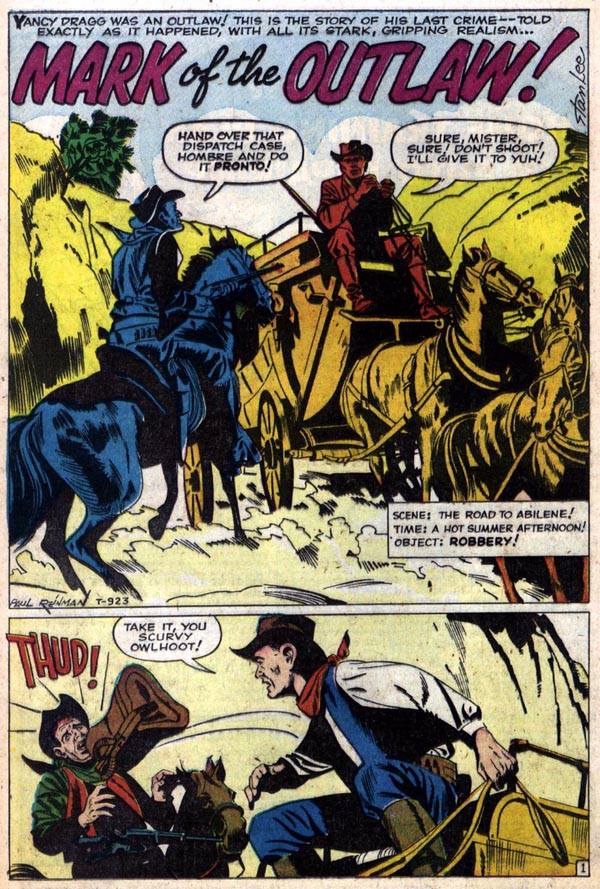
Lee painted over other people's signatures
Ferran Delgado: It's curious that the only Western story by Kirby released the same month than FF #1 he was omitted and Lee got all the credit
Patrick Ford: It could be because Kirby wasn't ever in the habit of signing his stuff.
Ferran Delgado: Why did Ayers stop doing it suddenly that month?
Patrick Ford: I bet he didn't. I bet the signature is there but covered with white paint.
Ferran Delgado: Me too..
Patrick Ford: The question is why did Lee begin covering the Ayers/Kirby signature with white paint.
Michael Hill: -So-� regarding those Kirby / Ayers signatures-�
I always put the signatures on our work together just as I always sign my work. I noticed that the -�whiteouts' were happening and it sure didn't make me happy for I usually had the signature as part of the composition of the drawing. It was a sore point. I'm not keen on the credit boxes that are added to the drawing and confuse the composition of my drawing.-�
Dick Ayers, Kirby-L, the Jack Kirby Internet mailing list, 8 December 1998.
Ferran Delgado: This getting "better". This is a list of the comics where Kirby contributed the same month than FF #1, which is signed by Lee+Kirby. The ONLY comic signed by him was a romance, while the another romance had only Lee's signature.
Amazing Adventures (1961) #6 - Unsigned
Fantastic Four (1961) #1 - Unsigned
Gunsmoke Western (1955) #67 - Unsigned
Journey Into Mystery (1952) #74 - Unsigned
Kid Colt Outlaw (1948) #101 - Cover unsigned
Love Romances (1949) #96 - Signed Lee+Kirby
Strange Tales (1951) #90 - Unsigned
Tales of Suspense (1959) #23 - Unsigned
Tales to Astonish (1959) #25 - Unsigned
Teen-Age Romance (1960) #84 - Unsigned. Just Lee.
Ferran Delgado: Teen-Age Romance (1960) #84 - Unsigned. Just Lee.  Ferran Delgado: Teen-Age Romance (1960) #84 - Unsigned. Just Lee.
Ferran Delgado: Teen-Age Romance (1960) #84 - Unsigned. Just Lee. 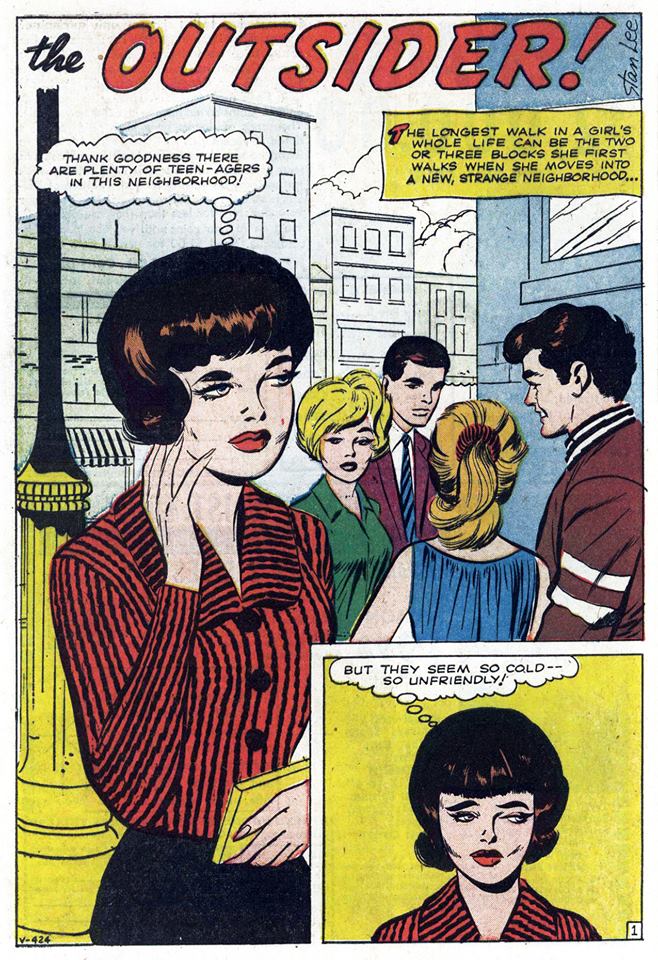 Ferran Delgado: More interesting. The following month NO story signed by Kirby.
-------------12/1961
Journey Into Mystery (1952) #75 - Unsigned
Strange Tales (1951) #91 - Unsigned
Tales of Suspense (1959) #24 - Unsigned
Tales to Astonish (1959) #26 - Unsigned
The Rawhide Kid (1955) #25 - Unsigned. Just Lee.
Ditko stories signed Lee+Ditko.
Reiman stories signed just by him.
Ferran Delgado: More interesting. The following month NO story signed by Kirby.
-------------12/1961
Journey Into Mystery (1952) #75 - Unsigned
Strange Tales (1951) #91 - Unsigned
Tales of Suspense (1959) #24 - Unsigned
Tales to Astonish (1959) #26 - Unsigned
The Rawhide Kid (1955) #25 - Unsigned. Just Lee.
Ditko stories signed Lee+Ditko.
Reiman stories signed just by him.
 Patrick Ford: It looks bad doesn't it? I would not exactly expect Lee to add Kirby's signature. And I don't think Kirby was in the habit of signing his work (probably because of the decades long "Produced by Simon and Kirby" identifications), but it sure looks funny when Lee is whiting out Kirby/Ayers signatures.
Ferran Delgado: Lee started covering the signatures in comics with cover date of October, 1961, because you can find signatures in September.
Patrick Ford: Coincides with FF #1.
Ferran Delgado: More or less, because FF #1 has cover date of November.
Ferran Delgado: He started the month before. I understand the possible relation with FF, but why would he start the month before?
Patrick Ford: Maybe FF #1 was delayed? Probably the Mole Man story was done first and intended to fit into one of the anthology books.
Ferran Delgado: But the key is that Lee just covers Kirby's signature, not Ditko's or Reinman's. Was he afraid of Kirby relevance?
Michael Hill: It occurred to him that he could get rich off Kirby's writing rate.
Patrick Ford: It looks bad doesn't it? I would not exactly expect Lee to add Kirby's signature. And I don't think Kirby was in the habit of signing his work (probably because of the decades long "Produced by Simon and Kirby" identifications), but it sure looks funny when Lee is whiting out Kirby/Ayers signatures.
Ferran Delgado: Lee started covering the signatures in comics with cover date of October, 1961, because you can find signatures in September.
Patrick Ford: Coincides with FF #1.
Ferran Delgado: More or less, because FF #1 has cover date of November.
Ferran Delgado: He started the month before. I understand the possible relation with FF, but why would he start the month before?
Patrick Ford: Maybe FF #1 was delayed? Probably the Mole Man story was done first and intended to fit into one of the anthology books.
Ferran Delgado: But the key is that Lee just covers Kirby's signature, not Ditko's or Reinman's. Was he afraid of Kirby relevance?
Michael Hill: It occurred to him that he could get rich off Kirby's writing rate.
home

 Ferran Delgado: http://ferrandelgado.blogspot.com/2008/05/ms-revelaciones-en-los-originales-de.html
Patrick Ford: There is something there. This should be easy to nail down. Someone must have posted high quality scans from AF #15 on the web.
Ferran Delgado: https://comicsforum.org/2012/08/13/the-art-of-the-cartoon-exploring-the-collections-of-the-library-of-congress-by-sara-w-duke/
Patrick Ford: Here's a large scan of a panel I found. Lot's of pencil including notes, guidelines, and pencil in the art which Ditko changed when he inked. No penciled in dialogue or captions.
Ferran Delgado: http://ferrandelgado.blogspot.com/2008/05/ms-revelaciones-en-los-originales-de.html
Patrick Ford: There is something there. This should be easy to nail down. Someone must have posted high quality scans from AF #15 on the web.
Ferran Delgado: https://comicsforum.org/2012/08/13/the-art-of-the-cartoon-exploring-the-collections-of-the-library-of-congress-by-sara-w-duke/
Patrick Ford: Here's a large scan of a panel I found. Lot's of pencil including notes, guidelines, and pencil in the art which Ditko changed when he inked. No penciled in dialogue or captions.
 Patrick Ford: Interesting that the caption, the dialogue, the note, and the artwork are all out of sync.
Patrick Ford: Particularly the way the caption contradicts the dialogue.
erran Delgado: For example, in the third page Stan Lee writes Steve Ditko a short note in the lower margin of the page that affects art that had already been inked, -Steve, make this a sedan -� no arms hanging -� don't imply wild reckless driving.-�
Patrick Ford: Interesting that the caption, the dialogue, the note, and the artwork are all out of sync.
Patrick Ford: Particularly the way the caption contradicts the dialogue.
erran Delgado: For example, in the third page Stan Lee writes Steve Ditko a short note in the lower margin of the page that affects art that had already been inked, -Steve, make this a sedan -� no arms hanging -� don't imply wild reckless driving.-�
 Ferran Delgado: If rulers are visible, no erasing was done in balloons and captions.
Ferran Delgado: Each page of the SpM Masterworks has comments by Bell where includes the notes at the margins.
Patrick Ford: AF #15 was published the same month as FF # 5 which has Lee's penciled dialogue in the balloons and if I recall what looks like traces of Kirby's penciled lettering in the balloons.
Ferran Delgado:
Ferran Delgado: If rulers are visible, no erasing was done in balloons and captions.
Ferran Delgado: Each page of the SpM Masterworks has comments by Bell where includes the notes at the margins.
Patrick Ford: AF #15 was published the same month as FF # 5 which has Lee's penciled dialogue in the balloons and if I recall what looks like traces of Kirby's penciled lettering in the balloons.
Ferran Delgado:

 Patrick Ford: I think I can find an example where it's pretty clear there is penciled lettering by Kirby and Lee in the same balloon. I've seen it before and just need to find a good example.
Ferran Delgado: If you can see the rulers, Lee didn't erase it.
Ferran Delgado:
Patrick Ford: I think I can find an example where it's pretty clear there is penciled lettering by Kirby and Lee in the same balloon. I've seen it before and just need to find a good example.
Ferran Delgado: If you can see the rulers, Lee didn't erase it.
Ferran Delgado:
 Ferran Delgado: Lettering by Lee in the balloons, as told by Bell in his notes.
Ferran Delgado: Lettering by Lee in the balloons, as told by Bell in his notes.
 Patrick Ford: I can see some in there but not on some other pages.
Patrick Ford: Here's a good example of Lee lettering in pencil on the art pages. This is ASM #7 from 1963.
Patrick Ford: I can see some in there but not on some other pages.
Patrick Ford: Here's a good example of Lee lettering in pencil on the art pages. This is ASM #7 from 1963.

 Ferran Delgado:
Ferran Delgado:
 Patrick Ford: "Bill" .... Everett? The "give to stripper" note is funny even though it does not refer to a Janet Clover type stripper.
Ferran Delgado: https://ohdannyboy.blogspot.com/2013/04/who-created-amazing-spider-man-amazing.html
Michael Hill: Where does Best come up with such nonsense? He uses this diatribe to say Kirby accused Ditko of theft, and Ditko rebutted *Kirby's* claim. I'd say Kirby and Ditko are in agreement against Lee.
Patrick Ford: Further study is needed but it seems Lee began penciling in dialogue and captions on the art boards right around the time he began taking published credits credits in the comic books. Prior to that he must have been typing a "dialogue script" And after a short time he returned to typing the dialogue rather than penciling it on the art.
Patrick Ford: At Tom Kraft's "What If Kirby" page FF #3 has Lee's penciled lettering on the original art. By issue #9 it looks to be gone and Lee is just doing balloon placements and sound effects in pencil.
Patrick Ford: FF #13 is a good issue to examine. Ditko does not waste time doing heavy erasing. It's easy to see the way he's not following Kirby's pencils very closely. See the shading Ditko ignores on the Thing's torso in panel eight. It should be easy to see any penciled lettering in the balloons on the page and there is none.
Patrick Ford: "Bill" .... Everett? The "give to stripper" note is funny even though it does not refer to a Janet Clover type stripper.
Ferran Delgado: https://ohdannyboy.blogspot.com/2013/04/who-created-amazing-spider-man-amazing.html
Michael Hill: Where does Best come up with such nonsense? He uses this diatribe to say Kirby accused Ditko of theft, and Ditko rebutted *Kirby's* claim. I'd say Kirby and Ditko are in agreement against Lee.
Patrick Ford: Further study is needed but it seems Lee began penciling in dialogue and captions on the art boards right around the time he began taking published credits credits in the comic books. Prior to that he must have been typing a "dialogue script" And after a short time he returned to typing the dialogue rather than penciling it on the art.
Patrick Ford: At Tom Kraft's "What If Kirby" page FF #3 has Lee's penciled lettering on the original art. By issue #9 it looks to be gone and Lee is just doing balloon placements and sound effects in pencil.
Patrick Ford: FF #13 is a good issue to examine. Ditko does not waste time doing heavy erasing. It's easy to see the way he's not following Kirby's pencils very closely. See the shading Ditko ignores on the Thing's torso in panel eight. It should be easy to see any penciled lettering in the balloons on the page and there is none.
 https://whatifKirby.com/gallery/comic-art-listings/fantastic-four-issue-13-page-22
Patrick Ford: RAWHIDE KID #31, Dec. 1962 does not appear to have any penciled dialogue in the balloons.
https://whatifKirby.com/gallery/comic-art-listings/rawhide-kid-issue-31-page-5
Patrick Ford: RAWHIDE KID #28, June 1962 does show the penciled dialogue.
https://whatifKirby.com/gallery/comic-art-listings/rawhide-kid-issue-28-page-5
Ferran Delgado: By Lee.
Patrick Ford: Yes. It's Lee's penciled lettering.
Patrick Ford: Ferran Delgado, See what you can do with this page. I don't have the same tools you have and can't copy a zoomed image from What If. It looks to me like RAWHIDE KID #20 might have Kirby's lettering in the balloons.
https://whatifKirby.com/gallery/comic-art-listings/rawhide-kid-issue-20-3rd-story-page-1
Patrick Ford: Also of interest is the caption on the splash page (Chapter 2) for the new teenage Rawhide Kid. Hard to make out but the penciled lettering look to have the distinctive Kirby / to the right. It also looks typically precise. It's faint though and hard to see.
Ferran Delgado: I make screenshots of the zoomed image.
https://whatifKirby.com/gallery/comic-art-listings/fantastic-four-issue-13-page-22
Patrick Ford: RAWHIDE KID #31, Dec. 1962 does not appear to have any penciled dialogue in the balloons.
https://whatifKirby.com/gallery/comic-art-listings/rawhide-kid-issue-31-page-5
Patrick Ford: RAWHIDE KID #28, June 1962 does show the penciled dialogue.
https://whatifKirby.com/gallery/comic-art-listings/rawhide-kid-issue-28-page-5
Ferran Delgado: By Lee.
Patrick Ford: Yes. It's Lee's penciled lettering.
Patrick Ford: Ferran Delgado, See what you can do with this page. I don't have the same tools you have and can't copy a zoomed image from What If. It looks to me like RAWHIDE KID #20 might have Kirby's lettering in the balloons.
https://whatifKirby.com/gallery/comic-art-listings/rawhide-kid-issue-20-3rd-story-page-1
Patrick Ford: Also of interest is the caption on the splash page (Chapter 2) for the new teenage Rawhide Kid. Hard to make out but the penciled lettering look to have the distinctive Kirby / to the right. It also looks typically precise. It's faint though and hard to see.
Ferran Delgado: I make screenshots of the zoomed image.  Patrick Ford: I'm not convinced but I think the penciled SLU (slung) next to the inked ARE looks a lot like Kirby.
Ferran Delgado: I agree, but it's not definitive.
Patrick Ford: Hard to be certain but I think it looks more Kirby than Lee. Lee's printing is always poorly spaced and he wanders up and down from where you would expect the letters to share a baseline.______
Ferran Delgado: Hard to see who wrote it, not a clear word.
Ferran Delgado:
Patrick Ford: I'm not convinced but I think the penciled SLU (slung) next to the inked ARE looks a lot like Kirby.
Ferran Delgado: I agree, but it's not definitive.
Patrick Ford: Hard to be certain but I think it looks more Kirby than Lee. Lee's printing is always poorly spaced and he wanders up and down from where you would expect the letters to share a baseline.______
Ferran Delgado: Hard to see who wrote it, not a clear word.
Ferran Delgado:

 Patrick Ford: I wonder if the original art would be easier to read. Kirby's forms are distinctive. Particularly his R. Kirby also letters with a consistent forward lean //// and his letters are remarkably well spaced and grounded for someone not using guide lines. _____
Ferran Delgado: Another page from the comic at lesser resolution. Still hard to see. ()
Ferran Delgado: In this one it looks Lee's writing to me.
Patrick Ford: What about "Chapter 2" on the #18 splash?
https://whatifKirby.com/gallery/comic-art-listings/rawhide-kid-issue-18-page-8
Ferran Delgado: This is it!! From the #18 splash.
Patrick Ford: I wonder if the original art would be easier to read. Kirby's forms are distinctive. Particularly his R. Kirby also letters with a consistent forward lean //// and his letters are remarkably well spaced and grounded for someone not using guide lines. _____
Ferran Delgado: Another page from the comic at lesser resolution. Still hard to see. ()
Ferran Delgado: In this one it looks Lee's writing to me.
Patrick Ford: What about "Chapter 2" on the #18 splash?
https://whatifKirby.com/gallery/comic-art-listings/rawhide-kid-issue-18-page-8
Ferran Delgado: This is it!! From the #18 splash.  Patrick Ford: That's got to be Kirby.
Ferran Delgado: I agree!
Ferran Delgado: In a comic by Lee and Kirby.
Patrick Ford: And from the origin story no less.
Patrick Ford: Very interesting. Now will come the claims this confirms Lee was still writing full scripts at that time. (Oct. 1960).
Ferran Delgado: It's a possibility.
Patrick Ford: It is a possibility.
I wonder if Rand Hoppe or Tom Kraft can come up with a higher quality scan of that RAWHIDE KID #18 caption.
Patrick Ford: Tom's "What If Kirby" page has four pages from TWO-GUN KID #58, Feb. 1961. There are two pages from one story and two pages from another. All the pages look to have Kirby's penciled lettering in the balloons and captions. One of the pages has penciled lettering by Kirby and Lee in the same panel.
See the panel reading "Strangers gotta mind their manners."
https://whatifKirby.com/gallery/comic-art-listings/two-gun-kid-issue-58-page-1
Patrick Ford: One of the stories is a Western monster story "The Monster of Hidden Valley!" signed by Stan Lee and it clearly has Kirby's penciled lettering in the balloons and captions.
https://whatifKirby.com/gallery/comic-art-listings/two-gun-kid-issue-58-page-5
Patrick Ford: Splash page from "Chapter 2" of "The Monster of Hidden Valley." "Chapter 2" is lettered in pencil by Kirby and Kirby's lettering is in the balloons. http://https://whatifKirby.com/gallery/comic-art-listings/two-gun-kid-issue-58-page-8
Rand Hoppe:
Patrick Ford: That's got to be Kirby.
Ferran Delgado: I agree!
Ferran Delgado: In a comic by Lee and Kirby.
Patrick Ford: And from the origin story no less.
Patrick Ford: Very interesting. Now will come the claims this confirms Lee was still writing full scripts at that time. (Oct. 1960).
Ferran Delgado: It's a possibility.
Patrick Ford: It is a possibility.
I wonder if Rand Hoppe or Tom Kraft can come up with a higher quality scan of that RAWHIDE KID #18 caption.
Patrick Ford: Tom's "What If Kirby" page has four pages from TWO-GUN KID #58, Feb. 1961. There are two pages from one story and two pages from another. All the pages look to have Kirby's penciled lettering in the balloons and captions. One of the pages has penciled lettering by Kirby and Lee in the same panel.
See the panel reading "Strangers gotta mind their manners."
https://whatifKirby.com/gallery/comic-art-listings/two-gun-kid-issue-58-page-1
Patrick Ford: One of the stories is a Western monster story "The Monster of Hidden Valley!" signed by Stan Lee and it clearly has Kirby's penciled lettering in the balloons and captions.
https://whatifKirby.com/gallery/comic-art-listings/two-gun-kid-issue-58-page-5
Patrick Ford: Splash page from "Chapter 2" of "The Monster of Hidden Valley." "Chapter 2" is lettered in pencil by Kirby and Kirby's lettering is in the balloons. http://https://whatifKirby.com/gallery/comic-art-listings/two-gun-kid-issue-58-page-8
Rand Hoppe:  Patrick Ford: Thanks.
Ferran Delgado: The last line written by Kirby matches with the lettering.
Patrick Ford: It would be great if Rand Hoppe and Tom Kraft could examine closely all pages from the 1958-1962 era which they have scanned but have not yet posted. If "What If Kirby" was still an ongoing concern the 1958-1962 era would make a good sub-section.
Ferran Delgado: With the change of the name, Amazing Adult Fantasy #7 (12/1961) features only Ditko stories and they are credited in the splash and in the credits pages.
Patrick Ford: Thanks.
Ferran Delgado: The last line written by Kirby matches with the lettering.
Patrick Ford: It would be great if Rand Hoppe and Tom Kraft could examine closely all pages from the 1958-1962 era which they have scanned but have not yet posted. If "What If Kirby" was still an ongoing concern the 1958-1962 era would make a good sub-section.
Ferran Delgado: With the change of the name, Amazing Adult Fantasy #7 (12/1961) features only Ditko stories and they are credited in the splash and in the credits pages.  Ferran Delgado: Even in the cover!
Ferran Delgado: Even in the cover!  Ferran Delgado: Amazing Adventures #6 included a Kirby story unsigned (unusual), a story signed by Lee+Ditko, and a Paul Reinman just signed by him.
Ferran Delgado: Amazing Adventures #5 featured an unsigned Kirby story, another Don Heck unsigned story, and a Ditko story signed only by Ditko.
Patrick Ford: I'm pretty sure it was Ayers who signed all the Kirby/Ayers stories. The stories inked by Klein, Everett, Reinman and others are never signed.
Ferran Delgado: Amazing Adventures #6 included a Kirby story unsigned (unusual), a story signed by Lee+Ditko, and a Paul Reinman just signed by him.
Ferran Delgado: Amazing Adventures #5 featured an unsigned Kirby story, another Don Heck unsigned story, and a Ditko story signed only by Ditko.
Patrick Ford: I'm pretty sure it was Ayers who signed all the Kirby/Ayers stories. The stories inked by Klein, Everett, Reinman and others are never signed.  Mark Stichman: I think this one here is inked by Reinman.
Patrick Ford: Mark Stichman , It is. That's why it isn't signed. Reinman did sign work which he penciled but didn't sign stories penciled by Kirby which he inked.
Ferran Delgado: But GCD credits Ayers in 'Amazing Adventures' #5 which is unsigned. http://www.comics.org/issue/16503/
Patrick Ford: Around 1961 Lee began covering the Ayers "Kirby / Ayers" signature with white paint and then signing the stories Stan Lee and J. Kirby.
Mark Stichman: I think this one here is inked by Reinman.
Patrick Ford: Mark Stichman , It is. That's why it isn't signed. Reinman did sign work which he penciled but didn't sign stories penciled by Kirby which he inked.
Ferran Delgado: But GCD credits Ayers in 'Amazing Adventures' #5 which is unsigned. http://www.comics.org/issue/16503/
Patrick Ford: Around 1961 Lee began covering the Ayers "Kirby / Ayers" signature with white paint and then signing the stories Stan Lee and J. Kirby.  Ferran Delgado: This Kirby signature sure doesn't looks like done by him.
Patrick Ford: Roy Thomas said it was Stan Lee who wrote the signatures like that.
Ferran Delgado: This Kirby signature sure doesn't looks like done by him.
Patrick Ford: Roy Thomas said it was Stan Lee who wrote the signatures like that.  Patrick Ford:
Patrick Ford:  Ferran Delgado: It's curious that 'Amazing Adult Fantasy' #7 with the cover signed by Lee got released the next month than FF #1. When Lee signed the cover, FF #1 still didn't hit the stores, but probably he knew that it was something important.
Ferran Delgado: More curious. The same month that FF #1 got released, NO story by Kirby is signed, while the Ditko stories are signed by Lee+Ditko.
Ferran Delgado: Oh, and Lee didn't sign any story by Reinman.
Ferran Delgado: The stories inside of Kid Colt Outlaw #101 are signed by Lee and Keller/Ayers. Gunsmoke Western #67 has two stories signed by Lee+Ayers and another one by Lee+Keller. Kirby's are only signed by Lee.
Ferran Delgado: It's curious that 'Amazing Adult Fantasy' #7 with the cover signed by Lee got released the next month than FF #1. When Lee signed the cover, FF #1 still didn't hit the stores, but probably he knew that it was something important.
Ferran Delgado: More curious. The same month that FF #1 got released, NO story by Kirby is signed, while the Ditko stories are signed by Lee+Ditko.
Ferran Delgado: Oh, and Lee didn't sign any story by Reinman.
Ferran Delgado: The stories inside of Kid Colt Outlaw #101 are signed by Lee and Keller/Ayers. Gunsmoke Western #67 has two stories signed by Lee+Ayers and another one by Lee+Keller. Kirby's are only signed by Lee.  Patrick Ford: Reinman did a few Westerns in 1960 which he signed and which were also signed by Lee.
Patrick Ford: Reinman did a few Westerns in 1960 which he signed and which were also signed by Lee. 
 Ferran Delgado: Teen-Age Romance (1960) #84 - Unsigned. Just Lee.
Ferran Delgado: Teen-Age Romance (1960) #84 - Unsigned. Just Lee.  Ferran Delgado: More interesting. The following month NO story signed by Kirby.
-------------12/1961
Journey Into Mystery (1952) #75 - Unsigned
Strange Tales (1951) #91 - Unsigned
Tales of Suspense (1959) #24 - Unsigned
Tales to Astonish (1959) #26 - Unsigned
The Rawhide Kid (1955) #25 - Unsigned. Just Lee.
Ditko stories signed Lee+Ditko.
Reiman stories signed just by him.
Ferran Delgado: More interesting. The following month NO story signed by Kirby.
-------------12/1961
Journey Into Mystery (1952) #75 - Unsigned
Strange Tales (1951) #91 - Unsigned
Tales of Suspense (1959) #24 - Unsigned
Tales to Astonish (1959) #26 - Unsigned
The Rawhide Kid (1955) #25 - Unsigned. Just Lee.
Ditko stories signed Lee+Ditko.
Reiman stories signed just by him.
 Patrick Ford: It looks bad doesn't it? I would not exactly expect Lee to add Kirby's signature. And I don't think Kirby was in the habit of signing his work (probably because of the decades long "Produced by Simon and Kirby" identifications), but it sure looks funny when Lee is whiting out Kirby/Ayers signatures.
Ferran Delgado: Lee started covering the signatures in comics with cover date of October, 1961, because you can find signatures in September.
Patrick Ford: Coincides with FF #1.
Ferran Delgado: More or less, because FF #1 has cover date of November.
Ferran Delgado: He started the month before. I understand the possible relation with FF, but why would he start the month before?
Patrick Ford: Maybe FF #1 was delayed? Probably the Mole Man story was done first and intended to fit into one of the anthology books.
Ferran Delgado: But the key is that Lee just covers Kirby's signature, not Ditko's or Reinman's. Was he afraid of Kirby relevance?
Michael Hill: It occurred to him that he could get rich off Kirby's writing rate.
Patrick Ford: It looks bad doesn't it? I would not exactly expect Lee to add Kirby's signature. And I don't think Kirby was in the habit of signing his work (probably because of the decades long "Produced by Simon and Kirby" identifications), but it sure looks funny when Lee is whiting out Kirby/Ayers signatures.
Ferran Delgado: Lee started covering the signatures in comics with cover date of October, 1961, because you can find signatures in September.
Patrick Ford: Coincides with FF #1.
Ferran Delgado: More or less, because FF #1 has cover date of November.
Ferran Delgado: He started the month before. I understand the possible relation with FF, but why would he start the month before?
Patrick Ford: Maybe FF #1 was delayed? Probably the Mole Man story was done first and intended to fit into one of the anthology books.
Ferran Delgado: But the key is that Lee just covers Kirby's signature, not Ditko's or Reinman's. Was he afraid of Kirby relevance?
Michael Hill: It occurred to him that he could get rich off Kirby's writing rate.